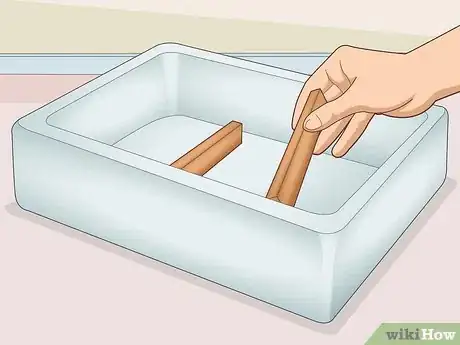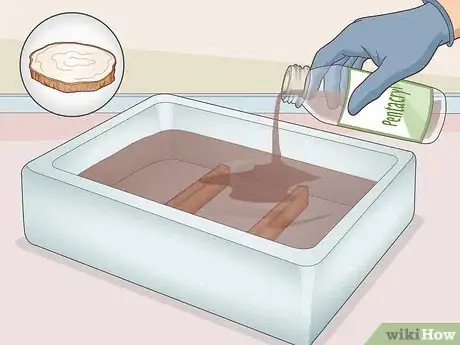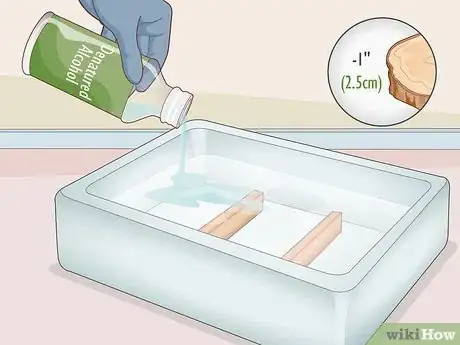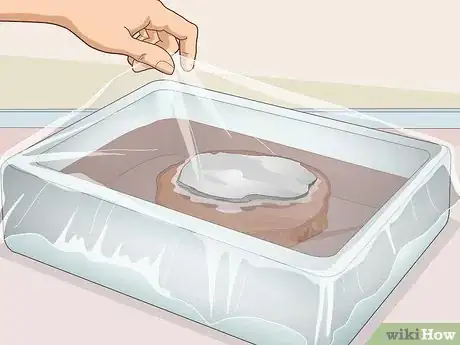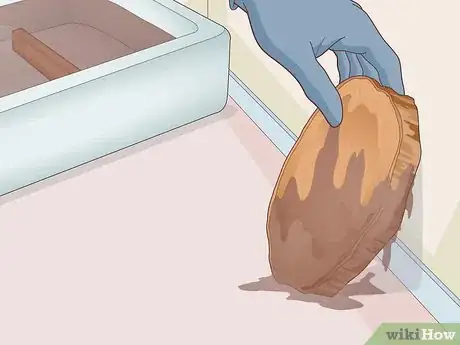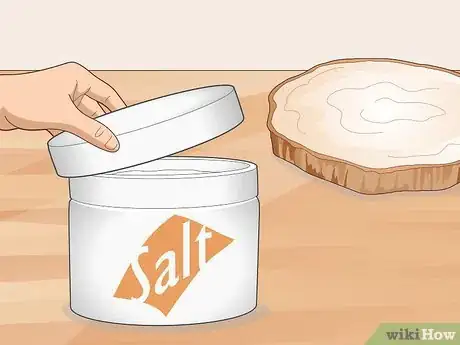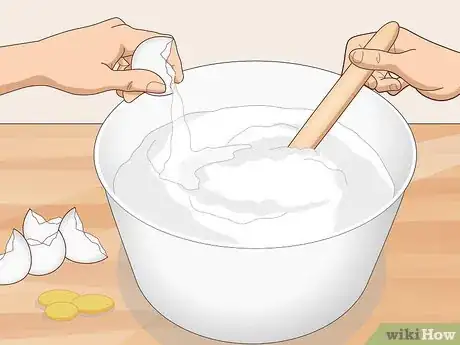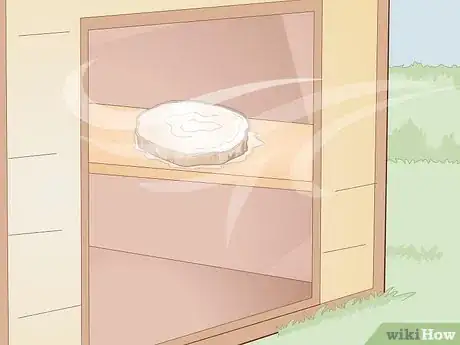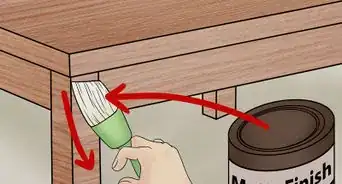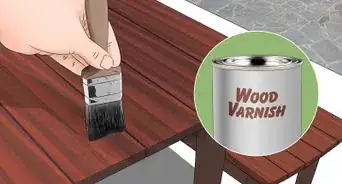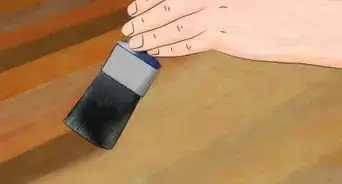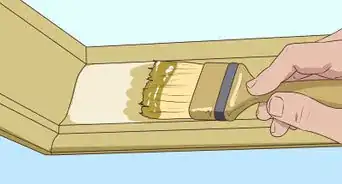This article was co-authored by wikiHow Staff. Our trained team of editors and researchers validate articles for accuracy and comprehensiveness. wikiHow's Content Management Team carefully monitors the work from our editorial staff to ensure that each article is backed by trusted research and meets our high quality standards.
There are 11 references cited in this article, which can be found at the bottom of the page.
wikiHow marks an article as reader-approved once it receives enough positive feedback. In this case, 94% of readers who voted found the article helpful, earning it our reader-approved status.
This article has been viewed 270,538 times.
Learn more...
Wood slices, also known as wood cookies, can be used for a variety of projects to add a rustic look and feel. As they dry, the moisture evaporates and the wood shrinks, which causes the slices to crack. Fortunately, you can ensure that your wood slices won’t crack as they dry by treating the wood with a stabilizing solution or a salt paste.
Things You Should Know
- If the slice is freshly cut, soak it in a tub of Pentarcryl for 24 hours per 1 inch (2.5 cm) of thickness.
- Soak the slice in wood sealer if it’s already partially dried, or denatured alcohol if the slice is less than 1 inch (2.5 cm) thick.
- Alternatively, mix a paste of table salt, water, cornstarch, and egg whites and brush it onto the slice. Let it air dry in a warm, well-ventilated area.
Steps
Soaking the Wood Slices
-
1Use a plastic, fiberglass, or stainless steel container that fits the slice. Choose a container that is large enough to fit your wooden slice. Use plastic, fiberglass, or stainless steel since some materials, including other metals, could damage or discolor the wooden slice.[1]
- Make sure the container is clean so there isn’t any dirt or chemicals that could alter the appearance of the wood slice.
-
2Place wooden slats on the bottom of the container to elevate the slices. Put 2-3 small wooden pieces or slats on the bottom of the container so you can rest the center of your wooden slice on top of it so the underside isn’t pressing against the bottom of the container. Try to use pieces or slats that are the same size so your wooden slice rests evenly on them.[2]
- You could also use small bricks or smooth stones to support the wood slice.
Advertisement -
3Put on a pair of rubber gloves to protect your hands. Use a pair of well-fitting rubber gloves so you’re able to open and pour the solutions without the risk of spilling or dropping them. Make sure there aren’t any holes or tears in the gloves so your skin isn’t exposed.[3]
- Latex or thick rubber gloves will work fine.
- The solutions could make you ill if it’s absorbed through your skin, so make sure you’re protected and wash them with soap and water immediately if you get some on your hands.
-
4Fill the container with Pentarcryl if the wood is freshly cut. Pentacryl is a specially formulated wood stabilizer that’s designed to keep green or fresh wood from cracking as it dries. If your wood slice was recently cut and hasn’t had a chance to air-dry yet, fill your container with Pentacryl to soak your wood.[4]
- Pour enough Pentacryl to fill your container about halfway to ⅔ full so it doesn’t overflow when you add your wood slice.
- You can find Pentacryl at woodworking supply stores or by ordering it online.
-
5Pour wood sealer into the container if the wood has partially dried. If your wooden slice was cut and left to dry for longer than a few days, use wood sealer as a soaking solution to help prevent cracks or splits from forming. Fill the container just over halfway so you can submerge the wooden slice without overflowing the container.[5]
- Wood sealers that are commonly used to prevent wooden slices from cracking as they dry include Wood Juice and Anchorseal.
- You can find quality wood sealers at woodworking supply stores, at hardware stores, or by ordering it online.
-
6Use denatured alcohol if the slice is less than 1 inch (2.5 cm) thick. Denatured alcohol, also known as wood alcohol, is pure ethanol with additives that make it toxic to consume. Thin wood slices soaked in denatured alcohol will dry without shrinking so quickly that cracks form. Fill your container just over halfway full with denatured alcohol so you can soak the slice without the liquid spilling over the sides.[6]
- Be careful not to breathe in the fumes of the alcohol when you add it to the container.
- Look for denatured alcohol at home improvement stores, at department stores, or online to order.
-
7Set the slice in the container, place a rock on it, and cover it with plastic. Carefully rest the wood slice on top of the small pieces or slats that you placed on the bottom of the container so you don’t splash the solution. Place a stone, rock, or brick on top of it so it doesn’t float. Wrap a layer of plastic wrap over the top of the container to keep the solution from evaporating and to help it soak into the wood.[7]
- The slice doesn’t need to be fully submerged in the solution to soak it up. As long as more than half of the slice is submerged, the wood will absorb the solution.
- Use standard plastic wrap to cover the container.
-
8Allow the wood to soak for 24 hours per 1 inch (2.5 cm) of thickness. Leave the wood slice in the container to soak undisturbed. As a general rule of thumb, give it a solid day for each 1 inch (2.5 cm) of the thickness of the slice so the solution can penetrate deep into the heart of the wood.[8]
- For thin slices in alcohol, let the wood soak for at least a day.
- Avoid checking on the slice or disturbing it so the solution can soak into the wood evenly.
-
9Remove the wood and store it on its side until it’s completely dry. Once the wood slice is saturated with the solution, put on a pair of rubber gloves and carefully take it out and allow the excess to run off into the container. Lean the slice against a wall or prop it up on its side in a warm, well-ventilated location such as a garage, basement, or shed. Let it dry for up to a week so the solution can evaporate and the wood can dry without cracking.[9]
- Thinner slices can dry in just a few days, but slices that are thicker than 5 inches (13 cm) could take up to a month.
- If the surface of the wood is moist or damp at all to the touch, then it isn’t dry yet.
Tip: Tape cardboard to the side of the slice or bury it in wood shavings to speed up the drying process.
Applying a Salt Paste
-
1Use a salt paste to naturally dry the wood out and restrict shrinkage. Salt is a natural drying agent that will help remove the moisture from the wood while also reducing the speed that the wood shrinks as it dries. Using salt is a simple way to help prevent cracks from forming as the wood dries without using harsh or pungent chemicals.[10]
-
2Mix 3 pounds (1.4 kg) of table salt with 1 gallon (3.8 L) of water. Fill a clean, medium-sized bucket with fresh water. Slowly pour in the salt so you don’t spill it or splash the water. Use a large spoon or stir stick to stir the solution well so it’s fully combined.[11]
- Even after you stir the mixture, you’ll still see some salt crystals floating in the water.
- Use standard table salt so it mixes better with the water.
- This amount of salt paste will allow you to coat several large slices of wood.
-
3Let the solution stand for 3-4 hours then add cornstarch to form a paste. Once you’ve added the salt and stirred the mixture, leave it to stand for a few hours so it can further combine with the water. Then, add about 1 cup (125 g) of corn starch at a time and stir the mixture well. Continue adding corn starch until it forms a thick paste that’s about the consistency of oil paint or cake batter.[12]
- If you accidentally add too much corn starch, and the paste is too hard, add some more water to the mixture to loosen it.
-
4Add 3 egg whites to the mixture and stir it well. When the mixture is the right consistency, slowly pour in the egg whites and stir it well to combine them. Continue mixing until the egg whites disappear into the paste to help keep it from flaking as the wood slice dries after you apply it.[13]
Tip: You can separate your own egg whites, or use .75 cups (180 mL) of liquid egg whites from a container.
-
5Cover the entire slice with the paste using a brush. Dip a clean paintbrush into the paste and spread it onto the wood slice using smooth, consistent strokes to create an even layer over the surface. Stand the slice on its side so you can paint the other side. Cover the whole slice, including the sides, so it dries evenly and won’t crack.[14]
- After a few minutes, the salt paste will begin to harden and soak into the wood and won’t be easily rubbed off.
-
6Place the wood in a warm, well-ventilated area to air dry. Once the slice is completely covered with the paste, place it somewhere warm that has good circulation such as a shelf in a garage or shed. The salt paste will draw the moisture out of the slice and keep it from shrinking too quickly and cracking. After about a week, check the wood to see if it’s fully dried.[15]
- Thick slices of wood can take a few weeks to fully dry. When the center of the wood is faded and the slice feels much lighter, then it’s dry.
Warnings
- Wear a pair of rubber gloves whenever you’re handling the solution you use to soak your wood slices to avoid exposing your skin to it.⧼thumbs_response⧽
References
- ↑ https://youtu.be/AzmiDPDmdoc?t=67
- ↑ https://youtu.be/AzmiDPDmdoc?t=78
- ↑ https://youtu.be/AzmiDPDmdoc?t=68
- ↑ https://youtu.be/n5_CR3Hvu1k?t=186
- ↑ https://youtu.be/n5_CR3Hvu1k?t=193
- ↑ https://www.woodworkingnetwork.com/best-practices-guide/solid-wood-machining/drying-disk-tree-possible-without-cracking-it
- ↑ https://youtu.be/AzmiDPDmdoc?t=98
- ↑ https://youtu.be/AzmiDPDmdoc?t=102
- ↑ https://youtu.be/AzmiDPDmdoc?t=126
- ↑ https://www.woodworkingnetwork.com/best-practices-guide/solid-wood-machining/drying-disk-tree-possible-without-cracking-it
- ↑ https://www.lsuagcenter.com/NR/rdonlyres/10B3631C-0D32-42D2-8FC3-7C5620C0F222/76576/pub2643stabilizingandbendingofwoodforthehobbyist20.pdf
- ↑ https://www.lsuagcenter.com/NR/rdonlyres/10B3631C-0D32-42D2-8FC3-7C5620C0F222/76576/pub2643stabilizingandbendingofwoodforthehobbyist20.pdf
- ↑ https://www.lsuagcenter.com/NR/rdonlyres/10B3631C-0D32-42D2-8FC3-7C5620C0F222/76576/pub2643stabilizingandbendingofwoodforthehobbyist20.pdf
- ↑ https://www.lsuagcenter.com/NR/rdonlyres/10B3631C-0D32-42D2-8FC3-7C5620C0F222/76576/pub2643stabilizingandbendingofwoodforthehobbyist20.pdf
- ↑ https://youtu.be/UupXXZ4kVfA?t=759

